previous
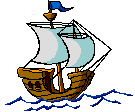
Some short piece of information could not lack about its “twin”, the Cristoforo Colombo school ship. Like I am saying in the previous pages, this ship came yielded to Russia in the year 1949 and then it was demolished in the year 1963. But, being much similar one to the Vespucci (in fact it was not real twin), it presses to me to report those little that it is known of this vessel and… they are own of news fragments.
In the year 1946 the Commander was the C.F. Giovanni Adalberto and the cruise itinerary was Taranto - Catania - Cagliari. The navigation from Taranto to Catania was carried out from 30th October to 4th November, it was calm and without details events. On 10th November the vessel sailed for Cagliari, but this time the Colombo ship came invested from a large storm, during three days, between 15th November and 18th November. The storm was truly strong, as well as that the Chief of general staff made a letter of “Praise”. But it was not the harder storm that Colombo ship had to face. In year 1947, during the navigation from Naples to Genoa, it happened from 20th January to 29th January, the ship runed up in a more tremendous one. It was so hard to cause huge damages to the equipments and to carry the ship quite outside from its route. The jib was torn so much that was opened in two pieces. They succeeded to find a good shelter in the Juan’s gulf and then to give bottom in calm waters near the Garoupe’s lighthouse.
One of the differences between the two vessels (Vespucci and Colombo) is in the masts. Colombo had more lows. An anecdote with regard this fact is which has happened when these two ships furrowed together the seas (you can think that show must be been). When the ship arrived to the Corinto’s Channel, the Vespucci ship touches, with the mast, under the bridge, while Colombo ship passes calmly. A second difference is that on Colombo ship it was not previewed that was the bridge, while on the Vespucci is the bridge to poop, where the official mounts of guard and where there is the rudder to four wheels. An other difference regards the plans. Colombo ship was constructed with two electric motors, everyone connected to a propeller. The two propellers had to be against rotary in order improving the maneuverability. Then it was all modifying, because thought useless, and the two propellers were made to turn in the same sense.
The first name of the Cristoforo Colombo was “Patria” and it came still changed when it was under construction. When it was yielded, the Russians was given the name to “Dunaj”. It was demolished in Glavvtorcement’s Naval Yard of the Turukhannye islands in Leningrado.

This vessel has been set up, constructed, launched and armed in only 409 days, it was a record. The Flag of Combat has been donated 15th October 1931 and it is guarded on board in a valuable cowling. His launch had happened some month before, just 22th February, and this date has a reason, it has an historical connection. On 22th February 1522 the navigator Amerigo Vespucci died, and this ship takes his name. The figurehead also represent this man, the navigator Amerigo Vespucci. The moment of the launch has been a thing much detail: to the cradle’s margins there were the ship yard workmen, they controlled every small movement of the hull, and from which for the joy an enormous roar has been raised, than quickly has joined in concert with the band’s sounds and the whistles of all the ships present in port.
Another Amerigo Vespucci existed previously to this one. It carried the same name and it was used as a ship school (from the year 1893). It was been a sail and motor cruise. 9th December 1879 in the Regal Arsenal of the Venezia was set up and was launched 31th July 1882.
The hull was in steel, with a displacement of 2.700 tons (our Vespucci has a displacement of 4.100 tons), and 3.300 horse-power engine (constructed from the Ansaldo di Sampierdarena’s Company). It had three masts with bowsprit and square sails and “of cut”.
It was employed initially above all abroad, like flagship. In the year 1893 it came used exclusively after school ship and carried out 26 Training Cruises. At the end of the year 1927, re-entry from the Training was placed on laying up. It was in Venice as an asylum ship for the education of the sailors orphans.
The last commander was the Commander Augusto Radicati di Marmorito, than he became the first Commander of the new Amerigo Vespucci.
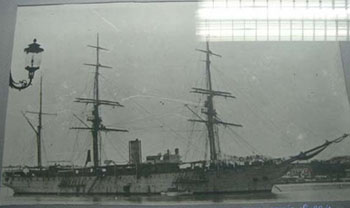
The first Vespucci
photo conserved to the Naval Museum of Venezia.
If the wind reinforces, naturally it is not necessary to open, or to keep open, all the sails. Generally the jibs, the stays are sufficient, the extremity and some “square sail” more small (as an example top gallant sail and royal sail). Main course (the largest sail) is the first one to lock because it becomes difficult to manage it (you can see the film of the Campaign Training 1965 Campaign Training 1965).
The men’s disposition on the yards is not fortuitous. Highest they come assigned to the lower yard and the contrary.
This because the students, in order to execute the maneuvers, must be with the supported feet to cables of steel (sidewalks) hanged up to the same yard. On the wider yard, that is those more low, the sidewalk is longer, and this allows the men higher than to be in the surer position: he’s standing, with the legs slightly spread and the abdomen to contact with the yard: top gallant yard, royal yard and fore topgallant yard instead does not concur of having sufficiently long sidewalks, therefore with an abundant handle, and consequently the higher persons would risk than to have the yard to the thighs height and to find itself therefore in uncertain equilibrium.
All the maneuvers are carried out with of the very precise rules. The students offer themselves in section on the main deck and they are assigned by the boatswain to the various ropes, connected to the yards through pulleys. Then, to the order of the petty officers, they must tow (to pull) the ropes with force, until the petty officer “does not pass the rough draft” and therefore it blocks temporarily the rope. At this point the students go up on the bulwarks, over the topgallant bulwarks, and to the order of the boatswain, they go up aloft (they scramble up on the shrouds) and they catch up own place of maneuver on the yard. When all the sailors are in position, the boatswain start the procedure to close the sails: the students must lean out, with the belly supported on the yard. Then they must pull on the sail, with all the force of their arms, and when all the sails are amassed, they must fix with appropriate strings called reef point. Then, the men climb down from the yards.
When the sails must be trimed, because it is changed the course or the wind’s direction is changed, are necessary to proceed to ulterior maneuvers. In this case they haul in the sheets, or the yards are oriented leeward better, working with the ropes windward or leeward. If the vessel go with fast pace the Commander change the course, in order to take less wind to the sails and to facilitate the hard work.
 The Vespucci ship in departure from Livorno - 9th July 2006.
The Vespucci ship in departure from Livorno - 9th July 2006.

The Vespucci ship is supplied of five winches and a loading crane (called Bigo). Two winches electrical workers, are found to prow, under the castle, and serve for the maneuvers of the bottom anchors. These are the only ones not to be maneuvered by hand. The others three in are covered: one is to the center, on the castle, and two, winches for warping are instead to breast; they come used manually or for the operations of warping, or in order to maneuver the sails. These maneuvers employees approximately twelve sailors.
The peak of cargo is berthed to the “spingone” and is enslaved from two winches electrical workers.
The drinkable water daily necessary on board is approximately of 70 tons. For this scope a evaporator-still produces every 24 hours 50 tons of water. That remaining comes taken from the tanks of the ship, that they have an ability to approximately 400 tons.
For the respect of the marine atmosphere, the systems of water purification are previewed of the details (black and grey).

With a crew in very harmony the ship “it puts in sail” during twenty minutes. And this is truly incredible, because that is 24 sails to explain to the wind and at least the double quantity of the maneuvers to carry out. For having a more complete idea, it is right also to know that in order to only border the 4 sails of stay (those smallest), halyards and sheets, windward and leeward, are necessary 25 sailors, plus others 4 that they have themselves hoisted on the ratlines of mast in order to free them of the ropes hold that them locked in order not to make to unravel them. The same operation then goes carried out when the stays are locked and the helmsmen go aloft in order to brail up the burlap so that it is not opened with the wind.
If the students do not learn “to the flight” the meaning of every word of the complex sailor’s slang, used on this vessel and often draft of terms not more in vigor on the modern ships, they risk to cover the deck with a inextricable tangle of ropes.
It is also a courage school: you need a lot of nerve to go up on the yards to explain the sails, or to lock them, when it is in arrival a storm.
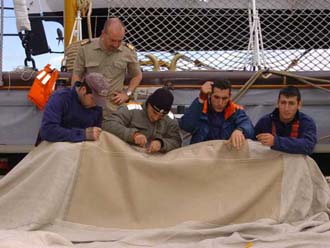
The Vespucci - one of the works
In the first part of the mast they have been necessary 2.400 nails. To this section the second part has been addition, it is in metal (fore-topmast) and at last the part in wood (fore topgallant mast).
This job, that it would have demanded normally approximately 18 months, was finished in 8 months, and these it was thanks to a careful preventive analysis, even if was always present… the unexpected fear. In this occasion they have been made also other intense activities, or of technological modernization, or to the hull; they have been removed and replaced 32 sheet courses and a total of 11.000 nails. It has been be a matter of carpentry operations, of ancient art, to demonstration that Italian Navy, through the Vespucci, conserve limbs and trades nearly disappeared.
And thus, the 1th February, the new foremast (it is approximately 34 m high) has been boarded with a crane, in order to be lowered inside, till the point more low: six decks more underneath!
And finally at 27th March the vessel has been able to return in its ideal atmosphere, to plunge himself into the La Spezia’s waters.
Ulterior news and particularity,
of miscellaneous kind, with regard to the Amerigo Vespucci school ship
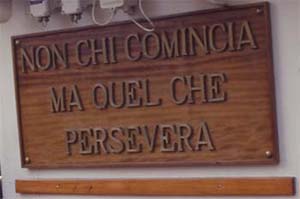
the motto
I am sure you have not been bored to read the precedence pages dedicated to the Amerigo Vespucci school ship. This ship is so detail, beyond that aesthetically beautiful, than it cannot make other that to fascinate! And then, I am here, and here there is a new page!
This time I have harvest several news fragments, that I have read in more articles or pieces of information, and that they will help you to complete that beautiful puzzle of this Mrs. of the Seas.
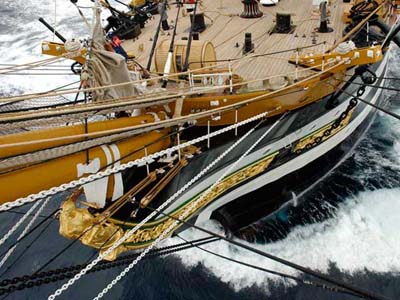
Vespucci is sailing
.
In the February 2006 this vessel was still found to the taken ones with of the great intense activities of maintenance.
This year in fact, with its 75 years, it was necessary to replace the foremast. It is which is found at the bow, that is in front, and is that exposed to a greater effort.
The peculiar is that it is intentional to make it exactly as what it has been removed and, in order to make this, they are due to use ago the same constructive techniques of 75 years ago. Curious therefore, to flank of the ship-engineering and electronic field’s specialist, they have been found to work also the ancient ship yard workmen.
One of these ancient handicraft constructive techniques is the assemblage of sheets with the nails to warmth. It is a method not more in use, so they have had to find four old ship yard workmen of the Arsenal, that they practiced the riveting’s ancient art and that they have worked in order to replace to new ours Mrs. of the Sea.
The several parts that compose the mast in fact have not been welded together, like they would have been easier, and fast, to make. A series of half-shells has been necessary therefore to join all using nails. The riveting is thought one of the better methods in order to assemble the parts.
The Vespucci masts are a large cylinder, cable inside, in which, in this occasion, one ship yard workmen has had itself to slip, reaching how far it has been possible, for being able to contrast the job of the nail’s riveting that came made outside. For the tightened part more of the mast, where the small ship yard workmen could not arrive, they have been used of the governed hydraulic rams from the outside with “maneuvers from magician”.

Besides to respect the artisan constructive tradition, there is several traditional workings presents now only in the La Spezia's Arsenal, also own on this vessel many “old” customs and memories are conserved, besides several “inherent memories” its numerous journeys.
Principal, between all the customs, is: the sailors use the spiders for the band’s honors, of which I have already spoken in the page "sails and masts and deepennings".
On board moreover it is guarded the original Combat Flag, which with the Royal coat of arms. It was delivered in the year 1931. This ship in fact is born at the times, and for the will, of the Marine Direction. In the entrance hall is present the torch’s support of the Roma-Olympic Games, than this ship has had the assignment to carry from Greece to Naples in the year 1960.
In the Council Room are exposed two oil paintings, representatives the disembarkation of Colombo to San Salvador and its re-enter in Spain, than they found on the “twin” Cristoforo Colombo.

At the conclusion of every Training Cruises the students have three important and demanding tasks.
In the first place they must give a name to their Course. This name comes chosen with a referendum during which they vote the several proposals made from the same students.
Then they must realize the flag, their flag!
This flag must recall the name of the Course and it must have like base the color identifies them.
At last they must create the hymn. It is composed, generally, with a series of unintelligible words, or quite invented, and, at the end, there is the name of their Course: it is a species of “combat hymn”.

On this ship are present a dentist, an operating theatre and an efficient ready infirmary to any requirement… hoping that somebody has never need!
Important intense activities, in order to adapt it to the new requirements, with modernization of the equipment both operating and logistic, have been made in the years 1951, 1958, 1964, 1973, 1984, 2001 and 2006.
.

Sometimes someone supports that the Amerigo Vespucci School Ship is born in the Venice’s Arsenal, rather than to Castellammare di Stabia (Napoli - Naples). If you have this doubt you must read the article, published in the web site of a friend. The title is “ The Amerigo Vespucci ship is born to Venezia or Castellammare di Stabia?"

An article of February 2003 report that the sails of the Vespucci, approximately mq 3.000, are in canvas and skin cowhide. Cowhide is used in order to reinforce the points of greater usury. They are made in the yards of the La Spezia's Arsenal in the old usage. They are cut, sewn and finished by hand from a square of 7 persons, in majority women because they have more accuracy to use the needle and the thread. In order to repair a sail of medium largeness (approximately mq 100) it wants a month to job. Recently the assignment to replace Vespucci’s sails has been given to the Zaoli Sails' Company. The same one has had need of 6.624 meters of hemp woven and linen from 22 ounces, fact to realize purposely, united to 516 meters of steel cable boltrope from 16 millimeter of diameter and 1.504 meters of cable boltrope of hemp from 36 millimeter of diameter. To finish off the “raligature” 236 kg of skin cowhide and 79.200 meters of waxed thread for the seams that have been realized manually. In total the sails are joined from 15.880 meters of seams, all rigorously made by hand, and weigh 5.036 kg.
The ropes, used for the maneuvers to the sails, and for the other inherent navigation operations, are in material vegetable. They are made with modern machinery, near the Maricorderia plant, of Italian Military Navy, to Castellammare di Stabia, but they are rigorously of hemp. On board of Vespucci school ship are 32 Km of “ropes” in use and others 32 km of escort in the holds. These ropes must be changed every year, at the end of the Training Cruise, when it re-enters to the naval base of La Spezia.
.

One of the things that are on board from 75 years, and it is integrating part of the history of this ship, is an old upright in walnut, supported to the wall of the quarter-deck.

The guard boatswain has the task to strike the bell every half on hour, from one to eight blows, during the four guard’s hours of the square.
Moreover during the night, always to the bell’s sound, the four lookout-posts disposed to bow, straight, poop and on the left (once they were five, the other it was in top) pass the voice, with a pre-arranged succession, in order to indicate that they are on the alert and that the navigation lights regularly are ignited with mark them of “good guard” to starboard (or left, or poop, or bow), green light ignited (or red, or of taffrail, or ready).
One of the Vespucci ship customs is: at two o’clock (on the night), during the navigation, when the cooks prepare the bread, they take out, by the oven, also the “pizza”. Naturally this is cooked only for the men who are at the moment in service: a tradition in order to lighten the cold and the hard work.
And on purpose of kitchen, it is interesting to know that they are served approximately 600 meals every day, in addition to the breakfasts, for the fixed staff; furthers 280 for the students (during the Training Cruise). Every day they prepare two first courses, two or three second course, one with the fish, side dish, the cake. All these courses are prepared from 20 cooks, petty officers, petty officers first class and simple sailors, nearly all graduates to the hotel school, who are alternated to the stoves in order to prepare breakfasts, lunches, suppers and, when it is necessary, also buffet of representation. A particularity: during these special occasions they come rigorously served produced of Italian tradition; thus, also in this way, the Vespucci abroad carries out its complete function of representation.
The alimentary kinds serve for approximately 3-5 months of navigation. Those that do not have conservation problems are stowed and are boarded from La Spezia, while those perishable are acquired, and they are boarded, in the ports of all the world where the ship carries out its pauses.

The differences of construction between Colombo ship and the Vespucci ship seem to go back to an event. The Cristoforo Colombo ship was launched in year 1928, this is the year in which happened a dramatic shipwreck: the Danish school ship Kobenhavn, a gigantic vessel to five masts, sank with its crew (60 men). As a result of such tragedy it was attempted to improve the emergency’s conditions of the new ships. It seems that also the Lieutenant Colonel Rotundi has held account in his successive plan, that one of the Amerigo Vespucci ship school.

In the May 2005, during the preparations for departure of Vespucci’s Training Cruise, some plants in vase was loaded on board, and they were arranged on the quarter … like from tradition.
It is a particularity that laughed them at the time of the first navigators, when they brought back the eatable plants from their shipments, or the exemplary botanists, and they were placed on the balcony to astern of the ship, because that is the more repaired point.
Own in a picture, which representative the scene in which the Bounty's Commander, William Bligh, is forced to abandon the ship and to go up on the nozzle, it is visible the plants collections, to scientific scope, to astern.
Sometimes in navigation it uses to say “to go to the quarter” in order to indicate that we have the smooth sailing. In this case the force of the wind according to diminishes the speed’s ship. If instead it sails close-hauled, the quarter is however the ideal place, because it is the part more repaired from waves and sprays.
For the report, the plants loaded on the Vespucci ship were two boxwoods (in order to remember the Italian’s garden), two plants of lemon (in order to remember the triumph over the scurvy) and a vase of rosemary (for the ….. roast of the crew!); the plants are re-entries however safe and sound in Italy!

The more prestigious and exclusive place of the Vespucci ship is the Council Room.
It is used only from the Commander and here he receive the High Representatives invited directly from the General Staff of Navy or from the same Commander.
Inside there is a great rectangular table, that you can see partially in the photo that I have had the honor to make with the Commander C.V. Liorsi and that you find in the page "on board".
The hosts take place around this table in a determined way: forehead to the Commander will be based the most important host; the table companions, in hierarchical order, are based to his right and on the right of this host, and then of continuation to its left. The places are for 10 persons maximum.
The rested, which they come used, are in silver and they are decided like from tradition of the year 1800, with the knife and spoon to right, two forks on the left and up the knife and the fork for the fruit or the dessert.
The wines come from the private wine cellar of the Commander and come indicated also in the menu, that it comes predisposed and printed specifically for the reception.
The meals are served from the sailors assigned to Council Room, called “young teachers”, that they wear the white gloves.